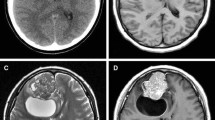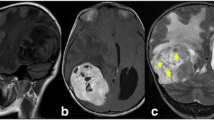Abstract
A 17-year-old male patient underwent surgery five times (four consecutive intracranial tumor removal surgeries and a final spinal tumor removal surgery). After the third surgery, this case was reported as a low-grade astroblastoma that is characterized by perivascular pseudorosettes consisting of elongated tumor cells arranged around the blood vessels. However, the fourth and fifth surgical specimens demonstrated very interesting histological changes in the astroblastoma. Through the course of relapses, the constituent cells of the astroblastic perivascular rosettes became smaller and rounder, and a multilayered cell arrangement was observed. The nucleus-to-cytoplasm ratio increased, and the compact intervascular cells ultimately lost glial fibrillary acidic protein (GFAP) expression. These undifferentiated cells showed high MIB-1 indices and an increased olig2 index. On the other hand, the cells in all the surgical specimens were positive for certain neuronal markers such as NSE, TUJ1, and nestin. Some astroblastomas may be more immature than the usual astrocytes; however, it is necessary to study more cases to confirm this.
Similar content being viewed by others
References
Bailey P, Cushing H (1926) Classification of the tumours of the glioma group on a histogenetic basis with a correlated study of prognosis. Lippincott, Montreal
Kaji M, Takeshima H, Nakazato Y, et al (2006) Low-grade astroblastoma recurring with extensive invasion. Neurol Med-Chir 46:450–454
Bannykh SI, Fan X, Black KL (2007) Malignant astroblastoma with rhabdoid morphology. J Neuro-Oncol 83:277–278
Alaraj A, Chan M, Oh S, et al (2007) Astroblastoma presenting with intracerebral hemorrhage misdiagnosed as dural arteriovenous fistula: review of a rare entity. Surg Neurol 67:308–313
Bell JW, Osborn AG, Salzman KL, et al (2007) Neuroradiologic characteristics of astroblastoma. Neuroradiology 49:203–209
Yunten N, Ersahin Y, Demirtas E, et al (1996) Cerebral astroblastoma resembling an extra-axial neoplasm. J Neuroradiol 23:38–40
Baka JJ, Patel SC, Roebuck JR, et al (1993) Predominantly extraaxial astroblastoma: imaging and proton MR spectroscopy features. AJNR 14:946–950
Kubota T, Sato K, Arishima H, et al (2006) Astroblastoma: immunohistochemical and ultrastructural study of distinctive epithelial and probable tanycytic differentiation. Neuropathology 26:72–81
Huhn SL, Yung Y, Cheshier S, et al (2005) Identification of phenotypic neural stem cells in a pediatric astroblastoma. J Neurosurg 103:446–450
Kim DS, Park SY, Lee SP (2004) Astroblastoma: a case report. J Korean Med Sci 19:772–776
Husain AN, Leestma JE (1986) Cerebral astroblastoma: immunohistochemical and ultrastructural features. Case report. J Neurosurg 64:657–661
Cabello A, Madero S, Castresana A, et al (1991) Astroblastoma: electron microscopy and immunohistochemical findings: case report. Surg Neurol 35:116–121
Caroli E, Salvati M, Esposito V, et al (2004) Cerebral astroblastoma. Acta Neurochir 146:629–633
Sugita Y, Terasaki M, Shigemori M, et al (2002) Astroblastoma with unusual signet-ring-like cell components: a case report and literature review. Neuropathology 22:200–205
Yamashita J, Handa H, Yamagami T, et al (1985) Astroblastoma of pure type. Surg Neurol 24:218–222
Hoag G, Sima AA, Rozdilsky B (1986) Astroblastoma revisited: a report of three cases. Acta Neuropathol 70:10–16
Bonnin JM, Rubinstein LJ (1989) Astroblastomas: a pathological study of 23 tumors, with a postoperative follow-up in 13 patients. Neurosurgery 25:6–13
Hata N, Shono T, Yoshimoto K, et al (2006) An astroblastoma case associated with loss of heterozygosity on chromosome 9p. J Neuro-Oncol 80:69–73
Miranda P, Lobato RD, Cabello A, et al (2006) Complete surgical resection of high-grade astroblastoma with long time survival: case report and review of the literature. Neurocirugia (Asturias, Spain) 17:60–63
Thiessen B, Finlay J, Kulkarni R, et al (1998) Astroblastoma: does histology predict biologic behavior? J Neuro-Oncol 40:59–65
Kubota T, Hirano A, Sato K, et al (1985) The fine structure of astroblastoma. Cancer (Phila) 55:745–750
Takebayashi H, Nabeshima Y, Yoshida S, et al (2002) The basic helix-loo-helix factor olig2 is essential for the development of motoneuron and oligodendrocyte lineages. Curr Biol 12:1157–1163
Setoguchi T, Kondo T (2004) Nuclear export of OLIG2 in neural stem cells is essential for ciliary neurotrophic factor-induced astrocyte differentiation. J Cell Biol 166:963–968
Pizer BL, Moss T, Oakhill A, et al (1995) Congenital astroblastoma: an immunohistochemical study. Case report. J Neurosurg 83:550–555
Shuangshoti S, Mitphraphan W, Kanvisetsri S, et al (2000) Astroblastoma: report of a case with microsatellite analysis. Neuropathology 20:228–232
Takebayashi H, Yoshida S, Sugimori M, et al (2000) Dynamic expression of basic helix-loop-helix Olig family members: implication of Olig2 in neuron and oligodendrocyte differentiation and identification of a new member, Olig3. Mech Dev 99: 143–148
Brat DJ, Hirose Y, Cohen KJ, et al (2000) Astroblastoma: clinicopathologic features and chromosomal abnormalities defined by comparative genomic hybridization. Brain Pathol (Zurich) 10:342–352
Kraus JA, Koopmann J, Kaskel P, et al (1995) Shared allelic losses on chromosomes 1p and 19q suggest a common origin of oligodendroglioma and oligoastrocytoma. J Neuropathol Exp Neurol 54: 91–95
Rubinstein LJ, Herman MM (1989) The astroblastoma and its possible cytogenic relationship to the tanycyte. An electron microscopic, immunohistochemical, tissue-and organ-culture study. Acta Neuropathol 78:472–483
Navarro R, Reitman AJ, de Leon GA, et al (2005) Astroblastoma in childhood: pathological and clinical analysis. Childs Nerv Syst 21:211–220
Author information
Authors and Affiliations
Corresponding author
Rights and permissions
About this article
Cite this article
Hirano, H., Yunoue, S., Kaji, M. et al. Consecutive histological changes in an astroblastoma that disseminated to the spinal cord after repeated intracranial recurrences: a case report. Brain Tumor Pathol 25, 25–31 (2008). https://doi.org/10.1007/s10014-007-0224-2
Received:
Accepted:
Published:
Issue Date:
DOI: https://doi.org/10.1007/s10014-007-0224-2




